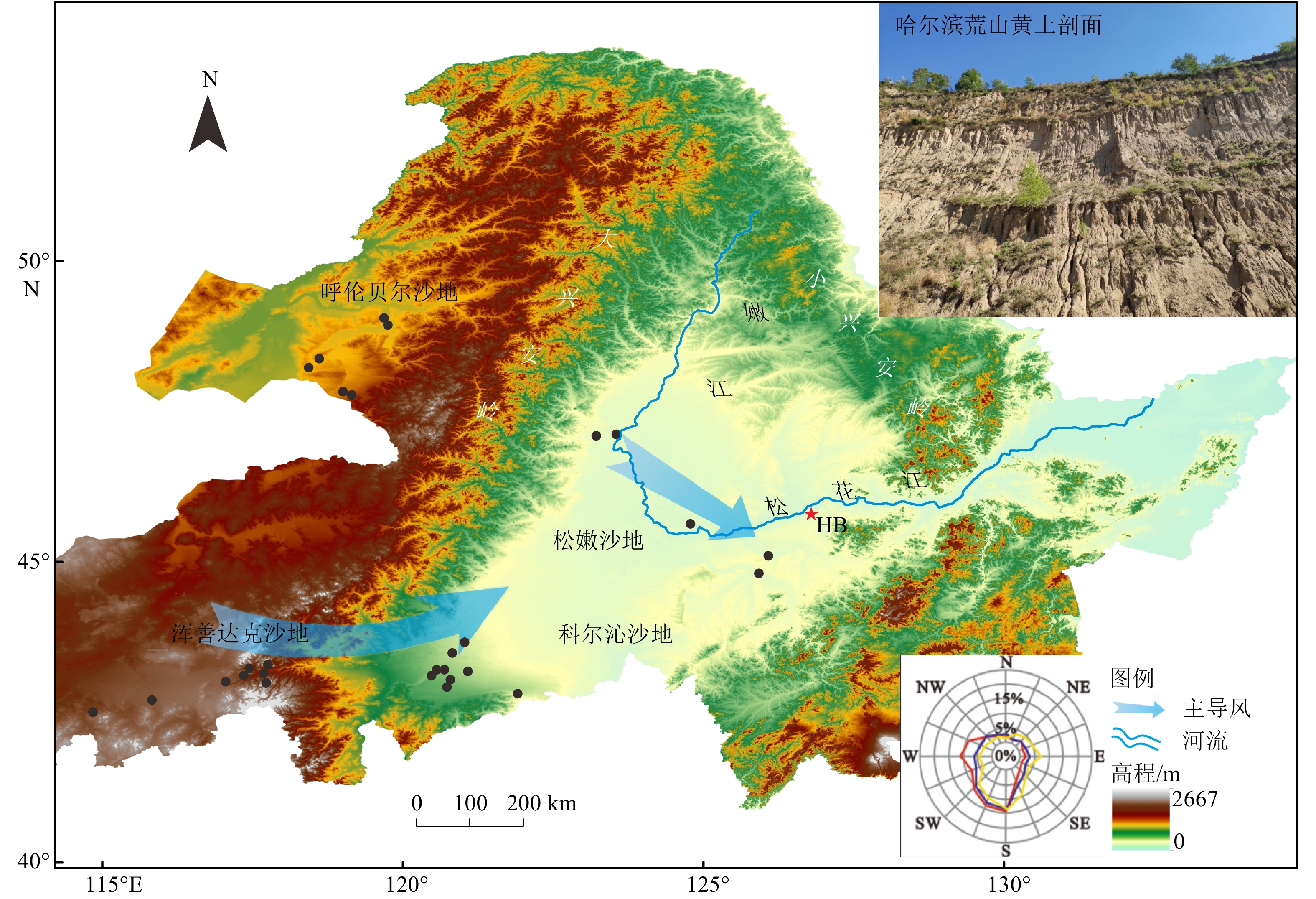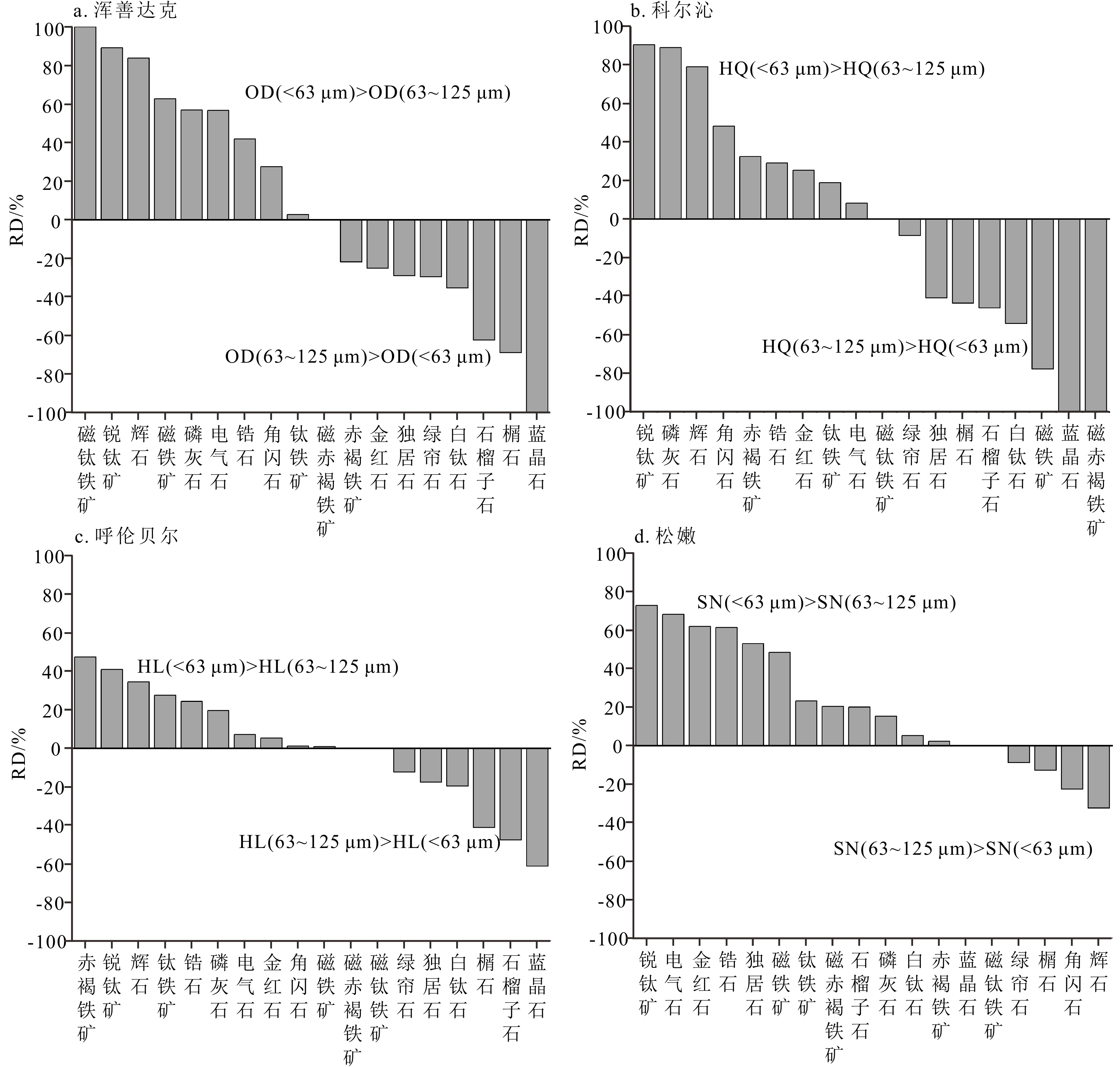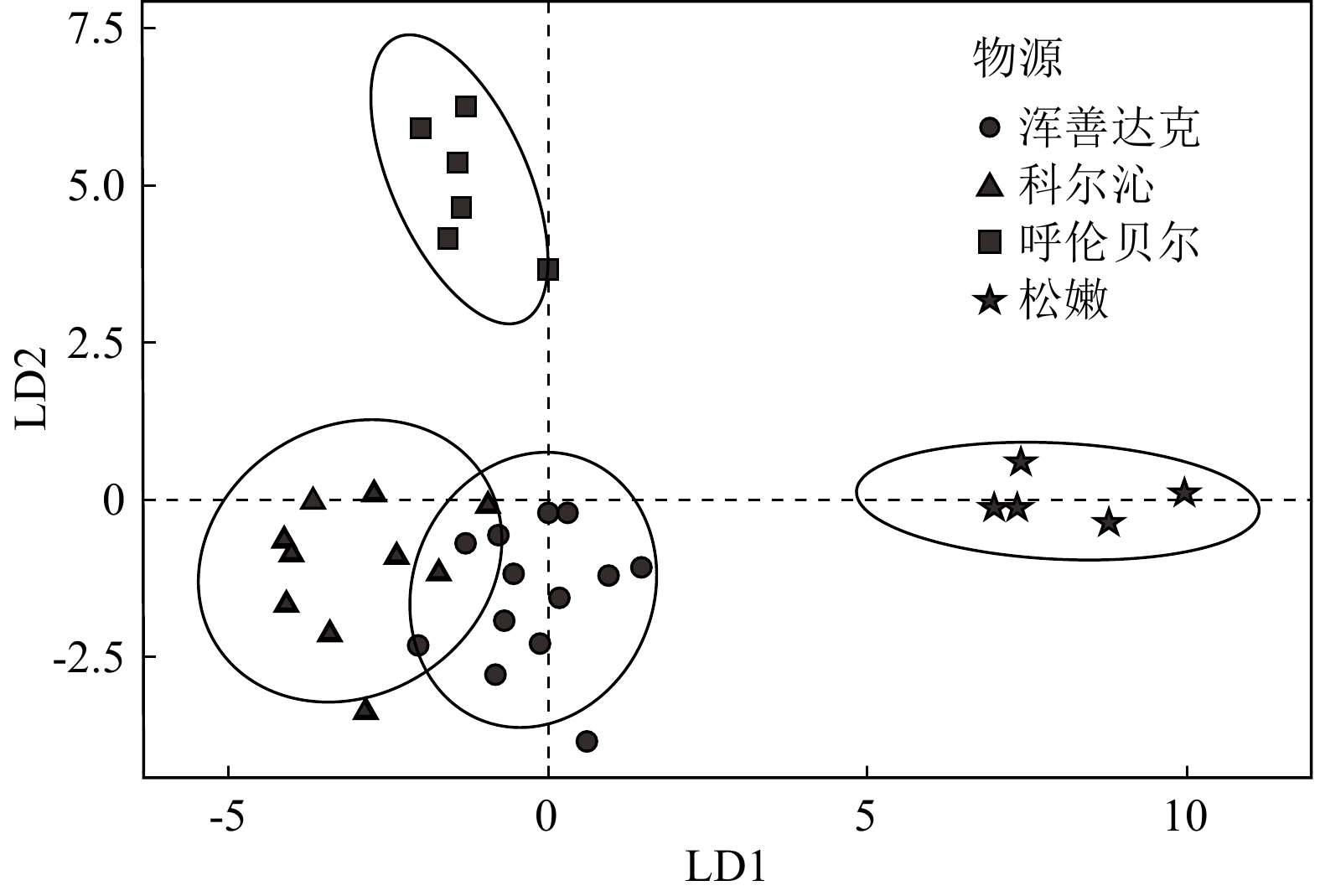Heavy mineral compositions in the northeast sandy lands and the provenance analysis
-
摘要:
了解中国东北沙地的重矿物组成并探讨其在亚洲风尘系统研究中的作用具有重要意义。目前较少甚至缺乏的重矿物数据,这影响了对该地区风尘系统的深入理解。为分析东北沙地的重矿物组成并探究其在东北风尘系统研究中的作用,分别从浑善达克沙地(OD)、科尔沁沙地(HQ)、呼伦贝尔沙地(HL)和松嫩沙地(SN)采集了34个风成沙和河流沙样品并进行了分粒级处理(<63 μm及63~125 μm)。同时,从哈尔滨荒山黄土剖面采集了4个末次冰期黄土样品(<63 μm),利用Frequentist模型对哈尔滨黄土物源进行了定量重建。通过范围检验、非参数Kruskal-Wallis H检验和逐步判别函数分析(DFA),选择了7种重矿物及特征指数(蓝晶石、锐钛矿、石榴子石、辉石、钛铁矿(磁性)、稳定系数W 、GZi指数)作为最佳复合指标进行定量重建。结果表明,钛铁矿(磁性)为浑善达克沙地的特征矿物,磁铁矿为科尔沁沙地的特征矿物,氧化铁矿物(赤铁矿、褐铁矿)为呼伦贝尔沙地的特征矿物,氧化铁矿物(磁性)、绿帘石、角闪石和石榴子石为松嫩沙地的优势矿物;不同粒度组分的重矿物含量存在明显差异,极稳定矿物优先富集于细颗粒。哈尔滨黄土与松嫩和呼伦贝尔沙地(<63 μm组分)具有相近的重矿物组成,而与浑善达克和科尔沁沙地有一定程度的差异。根据Frequentist模型,哈尔滨黄土的来源贡献依次为:松嫩沙地(44%~86%)、呼伦贝尔沙地(10%~39%)、科尔沁沙地(3%~16%)和浑善达克沙地(0~7%)。本研究突出了细颗粒沉积物的重矿物组成结合定量模型在风尘物源示踪研究中具有很好的应用前景。
Abstract:To understand the role of play in the Asian aeolian dust system, the heavy mineral composition of the sandy land in Northeast China was analyzed. At present, in-depth study in this regard is lacking, which limited our understanding of the wind dust system in this area. Therefore, 34 samples of eolian and fluvial sand were collected from Onqin Daga sandy land (OD), Horqin sandy land (HQ), Hulun Buir sandy land (HL), and Songnen sandy land (SN), from which two particle-size fractions (<63 μm, 63~125 μm) were processed and analyzed. In addition, four loess samples (<63 μm) of the Last Glacial Period were collected from a loess profile in barren mountains near Harbin. The source areas of the Harbin loess were reconstructed quantitatively in the Frequentist model. After the range test, non-parametric Kruskal-Wallis H-test, and stepwise discriminant function analysis, seven heavy minerals (kyanite, anatase, garnet, pyroxene, ilmenite etc), and four characteristic indices indicating anti-erosion ability and mother-rock composition were selected for quantitative reconstruction. Results show that ilmenite (magnetic) is the characteristic mineral of OD, magnetite is that of HQ, iron oxide minerals (hematite, limonite) are those of HL, and iron oxide minerals (magnetic), epidote, amphibole and garnet are dominant minerals of SN. The contents of heavy minerals in various grain size fractions are different, and highly stable minerals are preferentially enriched in fine particles. The Harbin loess and SN and HL (<63 μm component) have similar heavy mineral assemblages, but different from OD and HQ to some extents. The result of the Frequentist model shows that the contribution rate to the source of supply to the Harbin's loess is SN (44%~86%), HL (10%~39%), HQ (3%~16%), and OD (0~7%). This study highlights that the heavy mineral composition of fine sediment combined with the quantitative model has a good application prospect in the source tracing of wind dust.
-

-
表 1 中国东北部沙地与哈尔滨黄土重矿物统计
Table 1. Statistics of heavy minerals in sandy land of Northeast China and loess in Harbin
% 编号 锆石 磷灰石 蓝晶石 金红石 锐钛矿 白钛石 独居石 榍石 石榴子石 电气石 角闪石 绿帘石 钛铁矿 氧化铁矿物 辉石 磁铁矿 氧化铁矿物
(磁性)钛铁矿
(磁性)OD <63 μm 9.7 1.3 0 1.0 1.0 0.9 0.6 0.8 6.4 3.4 8.7 11.0 21.1 3.6 9.2 6.6 0 9.2 63~125 μm 4.0 0.4 0.2 1.7 0.1 1.9 1.2 4.3 27.4 0.9 5.0 20.2 20 5.7 0.8 1.5 0 0 HQ <63 μm 7.1 1.9 0 2.5 1.4 0.7 0.8 1.9 12.8 1.9 7.2 17.9 23.6 5.4 9.4 0.1 0 0 63~125 μm 3.9 0.1 0.2 1.5 0.1 2.3 1.9 4.8 34.6 1.6 2.5 21.2 16.1 2.7 1.1 0.6 0 0 HL <63 μm 8.9 1.2 0.1 1.1 0.3 1.5 0.3 1.8 10 1.2 9.4 13.2 21.4 13.6 0.4 7.2 0 0 63~125 μm 5.4 0.8 0.3 1.0 0.1 2.2 0.5 4.2 28.0 1.0 9.2 16.9 12.1 4.9 0.2 7.0 0 0 SN <63 μm 6.7 1.4 0 0.7 0.2 0.8 0.1 3.7 1.3 0.4 17.9 23.2 11.7 13.7 0.7 2.7 10 0 63~125 μm 1.6 1.0 0 0.2 0 0.7 0 4.8 0.9 0.1 28.2 27.7 7.3 13.0 1.3 0.9 6.6 0 <63 μm HB2 1.9 0 0 0.2 0.1 0.3 0 0.7 2.4 0.2 9.3 13.8 18.5 28.9 0 15.5 0 0 HB4 9.9 0.6 0 0.9 0.4 0.9 0 2.0 7.0 0.3 4.7 12.5 5.5 39.3 0.3 10.1 0 0 HB5 10 0.5 0 0.7 0.4 0.7 0 1.3 3.8 0.1 1.9 10.6 4.7 49.1 1.4 9.2 0 0 HB7 7.8 0.6 0 0.5 0.2 1.3 0 6.0 2.7 0 18.3 15.6 30.4 7.1 0 5.3 0 0 表 2 哈尔滨黄土定量物源混合贡献比例重建结果及标准差(SD)
Table 2. Quantitative reconstruction results and standard deviation of Harbin Loess provenance based on Frequentist model
样品号 浑善达克 科尔沁 呼伦贝尔 松嫩 GOF 比例/% SD 比例/% SD 比例/% SD 比例/% SD HB2 2 0.06 10 0.08 28 0.17 60 0.11 0.77 HB4 1 0.02 16 0.09 39 0.22 44 0.15 0.83 HB5 7 0.05 5 0.07 35 0.21 53 0.15 0.80 HB7 0 0.01 3 0.03 11 0.07 86 0.07 0.93 -
[1] Xie Y Y, Liu L, Kang C G, et al. Sr-Nd isotopic characteristics of the Northeast Sandy Land, China and their implications for tracing sources of regional dust [J]. CATENA, 2020, 184: 104303. doi: 10.1016/j.catena.2019.104303
[2] 崔颖颖, 周亚利, 陈国祥, 等. 毛乌素沙地样品扫描电镜的矿物定量分析[J]. 干旱区地理, 2020, 43(6):1505-1513
CUI Yingying, ZHOU Yali, CHEN Guoxiang, et al. Mineral quantitative analysis of Mu Us sandy land with QEMSCAN [J]. Arid Land Geography, 2020, 43(6): 1505-1513.
[3] Zhang C, Li Z L, Chen Q J, et al. Provenance of eolian sands in the Ulan Buh Desert, northwestern China, revealed by heavy mineral assemblages [J]. CATENA, 2020, 193: 104624. doi: 10.1016/j.catena.2020.104624
[4] 张诚. 阿拉善沙漠风积砂重矿物组成及物源分析[D]. 兰州大学硕士学位论文, 2020
ZHANG Cheng. Heavy mineral assemblages and provenance analysis of eolian sand in the Alashan Desert, Northwestern China[D]. Master Dissertation of Lanzhou University, 2011.
[5] 谢静, 丁仲礼. 中国东北部沙地重矿物组成及沙源分析[J]. 中国科学 D辑:地球科学, 2007, 50(11):1715-1723 doi: 10.1007/s11430-007-0110-0
XIE Jing, DING Zhongli. Compositions of heavy minerals in Northeastern China sandlands and provenance analysis [J]. Science in China Series D:Earth Sciences, 2007, 50(11): 1715-1723. doi: 10.1007/s11430-007-0110-0
[6] Morton A C. Heavy minerals in provenance studies[M]//Zuffa G G. Provenance of Arenites. Dordrecht: Springer, 1985: 249-277.
[7] Morton A C, Hallsworth C. Identifying provenance-specific features of detrital heavy mineral assemblages in sandstones [J]. Sedimentary Geology, 1994, 90(3-4): 241-256. doi: 10.1016/0037-0738(94)90041-8
[8] 赵红格, 刘池洋. 物源分析方法及研究进展[J]. 沉积学报, 2003, 21(3):409-415
ZHAO Hongge, LIU Chiyang. Approaches and prospects of provenance analysis [J]. Acta Sedimentologica Sinica, 2003, 21(3): 409-415.
[9] Nie J S, Peng W B, Pfaff K, et al. Controlling factors on heavy mineral assemblages in Chinese loess and Red Clay [J]. Palaeogeography, Palaeoclimatology, Palaeoecology, 2013, 381-382: 110-118. doi: 10.1016/j.palaeo.2013.04.020
[10] Peng W B, Wang Z, Song Y G, et al. A comparison of heavy mineral assemblage between the loess and the Red Clay sequences on the Chinese Loess Plateau [J]. Aeolian Research, 2016, 21: 87-91. doi: 10.1016/j.aeolia.2016.02.004
[11] 刘腾, 陈刚, 徐小刚, 等. 物源分析方法及其发展趋势[J]. 西北地质, 2016, 49(4):121-128 doi: 10.3969/j.issn.1009-6248.2016.04.002
LIU Teng, CHEN Gang, XU Xiaogang, et al. Methods and development trend of provenance analysis [J]. Northwestern Geology, 2016, 49(4): 121-128. doi: 10.3969/j.issn.1009-6248.2016.04.002
[12] 呼其图, 关平, 王大华, 等. 柴达木盆地北缘东段中侏罗统物源分析: 来自重矿物、元素地球化学及碎屑锆石年代学的证据[J/OL]. 沉积学报, 2022: 1-25. (2022-05-20) [2022-10-06]. https://doi.org/10.14027/j.issn.1000-0550.2022.044.
HU Qitu, GUAN Ping, WANG Dahua, et al. Provenance analysis of the middle Jurassic in Northeastern Qaidam Basin: Evidence from heavy minerals, elemental geochemistry and detrital zircon U-Pb geochronology[J/OL]. Acta Sedimentologica Sinica, 2022: 1-25. (2022-05-20) [2022-10-06]. https://doi.org/10.14027/j.issn.1000-0550.2022.044.
[13] 操应长, 宋玲, 王健, 等. 重矿物资料在沉积物物源分析中的应用: 以涠西南凹陷古近系流三段下亚段为例[J]. 沉积学报, 2011, 29(5):835-841
CAO Yingchang, SONG Ling, WANG Jian, et al. Application of heavy mineral data in the analysis of sediment source: A case study in the paleogene lower submember of the third member of the Liushagang Formation, Weixinan depression [J]. Acta Sedimentologica Sinica, 2011, 29(5): 835-841.
[14] Wu P, Xie Y Y, Li Y, et al. Decoupling between circulation pattern and dust path since the last glacial in the Songnen Plain, NE China: Insights from quantitative provenance reconstruction of the Harbin dust sediments [J]. Aeolian Research, 2022, 57: 100818. doi: 10.1016/j.aeolia.2022.100818
[15] Song Y G, Chen X L, Li Y, et al. Quantifying the provenance of dune sediments in the Taklimakan Desert using machine learning, multidimensional scaling and sediment source fingerprinting [J]. CATENA, 2022, 210: 105902. doi: 10.1016/j.catena.2021.105902
[16] Hu W J, Du S S, Tan L H, et al. Provenance and formation mechanism of Aeolian sands on the eastern bank of Co Nag Lake on the Qinghai-Xizang Plateau [J]. CATENA, 2022, 208: 105786. doi: 10.1016/j.catena.2021.105786
[17] García-Comendador J, Martínez-Carreras N, Fortesa J, et al. Combining sediment fingerprinting and hydro-sedimentary monitoring to assess suspended sediment provenance in a mid-mountainous Mediterranean catchment [J]. Journal of Environmental Management, 2021, 299: 113593. doi: 10.1016/j.jenvman.2021.113593
[18] Yang X P, Liang P, Zhang D G, et al. Holocene Aeolian stratigraphic sequences in the eastern portion of the desert belt (sand seas and sandy lands) in northern China and their palaeoenvironmental implications [J]. Science China Earth Sciences, 2019, 62(8): 1302-1315. doi: 10.1007/s11430-018-9304-y
[19] Chen B, Yang X P, Jiang Q D, et al. Geochemistry of Aeolian sand in the Taklamakan Desert and Horqin Sandy Land, northern China: Implications for weathering, recycling, and provenance [J]. CATENA, 2022, 208: 105769. doi: 10.1016/j.catena.2021.105769
[20] Yang X P, Li H W, Conacher A. Large-scale controls on the development of sand seas in northern China [J]. Quaternary International, 2012, 250: 74-83. doi: 10.1016/j.quaint.2011.03.052
[21] 裘善文. 中国东北西部沙地与沙漠化[M]. 北京: 科学出版社, 2008
QIU Shanwen. Sandy Land and Desertification in Western Northeast China[M]. Beijing: Science Press, 2008.
[22] Xie Y Y, Kang C G, Chi Y P, et al. Reversal of the middle-upper Songhua River in the late Early Pleistocene, Northeast China [J]. Geomorphology, 2020, 369: 107373. doi: 10.1016/j.geomorph.2020.107373
[23] 吴鹏, 谢远云, 康春国, 等. 哈尔滨荒山黄土的成因: 粒度、地球化学、磁化率、沉积和地貌特征的整合记录[J]. 地球学报, 2020, 41(3):420-430
WU Peng, XIE Yuanyun, KANG Chunguo, et al. The genesis of Huangshan loess in Harbin: integrated evidence from grain size, geochemistry, magnetization, sedimentation and landform [J]. Acta Geoscientica Sinica, 2020, 41(3): 420-430.
[24] 王嘉新, 谢远云, 康春国, 等. 哈尔滨荒山岩芯重矿物特征对松花江第四纪水系演化的指示[J]. 第四纪研究, 2020, 40(1):79-94
WANG Jiaxin, XIE Yuanyun, KANG Chunguo, et al. The indication of the heavy mineral characteristics of the core in Harbin Huangshan to the quaternary drainage evolution of Songhua river [J]. Quaternary Sciences, 2020, 40(1): 79-94.
[25] 孙磊, 谢远云, 康春国, 等. 呼伦贝尔沙地重矿物、Sr-Nd同位素组成及其对亚洲风尘系统的指示[J]. 中国地质, 2021, 48(6):1965-1974
SUN Lei, XIE Yuanyun, KANG Chunguo, et al. Heavy minerals, Sr-Nd isotopic composition of sandy land in Hulun Buir, Inner Mongolia and their implications for Asian aeolian dust system [J]. Geology in China, 2021, 48(6): 1965-1974.
[26] Shi G Z, Wang H, Huang C Y, et al. Provenance and tectonic setting of middle-upper Devonian sandstones in the Qinling Orogen (Shanyang area): New insights from geochemistry, heavy minerals and tourmaline chemistry [J]. Tectonophysics, 2016, 688: 11-25. doi: 10.1016/j.tecto.2016.09.023
[27] 李艳, 李安春, 黄朋. 大连湾近海表层沉积物重矿物组合分布特征及其物源环境指示[J]. 海洋地质与第四纪地质, 2011, 31(6):13-20
LI Yan, Li Anchun, HUANG Peng. Distribution of heavy mineral assemblages in subsurface sediments of Dalian Bay and their implications for provenance and environment [J]. Marine Geology & Quaternary Geology, 2011, 31(6): 13-20.
[28] Yang S Y, Wang Z B, Guo Y, et al. Heavy mineral compositions of the Changjiang (Yangtze River) sediments and their provenance-tracing implication [J]. Journal of Asian Earth Sciences, 2009, 35(1): 56-65. doi: 10.1016/j.jseaes.2008.12.002
[29] Zhang X J, Pease V, Omma J, et al. Provenance of Late Carboniferous to Jurassic sandstones for southern Taimyr, Arctic Russia: A comparison of heavy mineral analysis by optical and QEMSCAN methods [J]. Sedimentary Geology, 2015, 329: 166-176. doi: 10.1016/j.sedgeo.2015.09.008
[30] Hubert J F. A zircon-tourmaline-rutile maturity index and the interdependence of the composition of heavy mineral assemblages with the gross composition and texture of sandstones [J]. Journal of Sedimentary Research, 1962, 32(3): 440-450.
[31] Morton A C, Hallsworth C R. Processes controlling the composition of heavy mineral assemblages in sandstones [J]. Sedimentary Geology, 1999, 124(1-4): 3-29. doi: 10.1016/S0037-0738(98)00118-3
[32] 王中波, 杨守业, 李萍, 等. 长江水系沉积物碎屑矿物组成及其示踪意义[J]. 沉积学报, 2006, 24(4):570-578 doi: 10.3969/j.issn.1000-0550.2006.04.015
WANG Zhongbo, YANG Shouye, LI Ping, et al. Detrital mineral compositions of the Changjiang river sediments and their tracing implications [J]. Acta Sedimentologica Sinica, 2006, 24(4): 570-578. doi: 10.3969/j.issn.1000-0550.2006.04.015
[33] Li X J, Zan J B, Yang R S, et al. Grain-size-dependent geochemical characteristics of Middle and Upper Pleistocene loess sequences from the Junggar Basin: Implications for the provenance of Chinese eolian deposits [J]. Palaeogeography, Palaeoclimatology, Palaeoecology, 2020, 538: 109458. doi: 10.1016/j.palaeo.2019.109458
[34] Collins A L, Zhang Y, Walling D E, et al. Tracing sediment loss from eroding farm tracks using a geochemical fingerprinting procedure combining local and genetic algorithm optimisation [J]. Science of the Total Environment, 2010, 408(22): 5461-5471. doi: 10.1016/j.scitotenv.2010.07.066
[35] Gholami H, Rahimi S, Fathabadi A, et al. Mapping the spatial sources of atmospheric dust using GLUE and Monte Carlo simulation [J]. Science of the Total Environment, 2020, 723: 138090. doi: 10.1016/j.scitotenv.2020.138090
[36] Collins A L, Walling D E, Leeks G J L. Fingerprinting the origin of fluvial suspended sediment in larger river basins: combining assessment of spatial provenance and source type [J]. Geografiska Annaler:Series A, Physical Geography, 1997, 79(4): 239-254. doi: 10.1111/j.0435-3676.1997.00020.x
[37] 李思琪, 谢远云, 康春国, 等. 物源—河流过程—化学风化对松花江水系沉积物重矿物组成的影响[J]. 地质科学, 2022, 57(1):207-229
LI Siqi, XIE Yuanyun, KANG Chunguo, et al. Influence of provenance-river process-chemical weathering on heavy mineral composition of the Songhua River sediment [J]. Chinese Journal of Geology, 2022, 57(1): 207-229.
[38] 杨守业, 李从先. 长江与黄河现代表层沉积物元素组成及其示踪作用[J]. 自然科学进展, 1999, 9(10):930-937
YANG Shouye, LI Congxian. The composition and its tracing meaning of surficial sediments from the Changjiang and Huanghe River [J]. Advances of Natural Sciences, 1999, 9(10): 930-937.
[39] 孙磊. 呼伦贝尔沙地重矿物与Sr-Nd同位素组成特征研究[D]. 哈尔滨师范大学硕士学位论文, 2020
SUN Lei. Composition characteristics of heavy minerals and Sr-Nd isotopes in HulunBeier Sandy Land[D]. Master Dissertation of Harbin Normal University, 2020.
[40] Zhang X Y, Arimoto R, An Z S. Dust emission from Chinese desert sources linked to variations in atmospheric circulation [J]. Journal of Geophysical Research:Atmospheres, 1997, 102(D23): 28041-28047. doi: 10.1029/97JD02300
[41] Sun J M. Source regions and formation of the loess sediments on the high mountain regions of northwestern China [J]. Quaternary Research, 2002, 58(3): 341-351. doi: 10.1006/qres.2002.2381
[42] Rao W B, Yang J D, Chen J, et al. Sr-Nd isotope geochemistry of eolian dust of the arid-semiarid areas in China: Implications for loess provenance and monsoon evolution [J]. Chinese Science Bulletin, 2006, 51(12): 1401-1412.
[43] Chen J, Li G J, Yang J D, et al. Nd and Sr isotopic characteristics of Chinese deserts: Implications for the provenances of Asian dust [J]. Geochimica et Cosmochimica Acta, 2007, 71(15): 3904-3914. doi: 10.1016/j.gca.2007.04.033
[44] Shi Z G, Liu X D. Distinguishing the provenance of fine-grained eolian dust over the Chinese Loess Plateau from a modelling perspective [J]. Tellus B:Chemical and Physical Meteorology, 2011, 63(5): 959-970. doi: 10.1111/j.1600-0889.2011.00561.x
[45] Chen Z, Li G J. Evolving sources of eolian detritus on the Chinese Loess Plateau since early Miocene: Tectonic and climatic controls [J]. Earth and Planetary Science Letters, 2013, 371-372: 220-225. doi: 10.1016/j.jpgl.2013.03.044
[46] Nie J S, Peng W B. Automated SEM-EDS heavy mineral analysis reveals no provenance shift between glacial loess and interglacial paleosol on the Chinese Loess Plateau [J]. Aeolian Research, 2014, 13: 71-75. doi: 10.1016/j.aeolia.2014.03.005
[47] 刘瑾, 王永, 姚培毅, 等. 末次冰消期以来内蒙古东部气候变化: 基于风成砂-古土壤序列的地球化学记录[J]. 中国地质, 2015, 42(4):1103-1114
LIU Jin, WANG Yong, YAO Peiyi, et al. A study of paleoclimate changes in east Inner Mongolia since the Last deglaciation on the basis of Aeolian sand-paleosoil series geochemical records [J]. Geology in China, 2015, 42(4): 1103-1114.
[48] 袁方, 谢远云, 迟云平. 哈尔滨尘暴天气沉降物的物质组成及其对物源的限制[J]. 中国地质, 2018, 45(6):1177-1187
YUAN Fang, XIE Yuanyun, CHI Yunping. Material characteristics of dust fallouts during the dust-storm weather in Harbin: Constraint on the provenance [J]. Geology in China, 2018, 45(6): 1177-1187.
[49] Wu P, Xie Y Y, Chi Y P, et al. Loess accumulation in Harbin with implications for Late Quaternary aridification in the Songnen Plain, Northeast China [J]. Palaeogeography, Palaeoclimatology, Palaeoecology, 2021, 570: 110365. doi: 10.1016/j.palaeo.2021.110365
[50] 康春国, 李长安, 谢远云, 等. 哈尔滨地区风尘黄土重矿物特征及物源分析[J]. 自然灾害学报, 2011, 20(4):43-51 doi: 10.13577/j.jnd.2011.0407
KANG Chunguo, LI Chang’an, XIE Yuanyun, et al. Heavy mineral characteristics of eolian loess deposits in Harbin area and its provenance implications [J]. Journal of Natural Disasters, 2011, 20(4): 43-51. doi: 10.13577/j.jnd.2011.0407
[51] 谢远云, 孙磊, 康春国, 等. 松嫩沙地Sr-Nd同位素组成特征[J]. 沉积学报, 2020, 38(4):771-780
XIE Yuanyun, SUN Lei, KANG Chunguo, et al. Sr-Nd isotopic partition characteristics of the Songnen Sandy Land [J]. Acta Sedimentologica Sinica, 2020, 38(4): 771-780.
[52] 杜慧荣, 谢远云, 康春国, 等. 哈尔滨黄土的粒度与地球化学特征及其对粉尘物源的指示[J]. 中国沙漠, 2020, 40(1):64-76
DU Huirong, XIE Yuanyun, KANG Chunguo, et al. Grain-size and geochemical compositions of the Harbin loess deposits and their implications for eolian dust provenances [J]. Journal of Desert Research, 2020, 40(1): 64-76.
[53] 汪进秋, 谢远云, 康春国, 等. 中更新世以来的哈尔滨黄土物源变化: 来自TIMA自动定量矿物的证据[J]. 中国沙漠, 2022, 42(5):25-35
WANG Jinqiu, XIE Yuanyun, KANG Chunguo, et al. Changing provenance of Harbin loess since the Middle Pleistocene: Evidence from TIMA automated quantification of minerals [J]. Journal of Desert Research, 2022, 42(5): 25-35.
[54] Xie Y Y, Meng J, Guo L F. REE geochemistry of modern eolian dust deposits in Harbin city, Heilongjiang province, China: Implications for provenance [J]. CATENA, 2014, 123: 70-78. doi: 10.1016/j.catena.2014.07.008
[55] Xie Y Y, Chi Y P. Geochemical investigation of dry-and wet-deposited dust during the same dust-storm event in Harbin, China: Constraint on provenance and implications for formation of Aeolian loess [J]. Journal of Asian Earth Sciences, 2016, 120: 43-61. doi: 10.1016/j.jseaes.2016.01.025
[56] Ben-Israel M, Enzel Y, Amit R, et al. Provenance of the various grain-size fractions in the Negev loess and potential changes in major dust sources to the Eastern Mediterranean [J]. Quaternary Research, 2015, 83(1): 105-115. doi: 10.1016/j.yqres.2014.08.001
[57] Chen X L, Song Y G, Li J C, et al. Size-differentiated REE characteristics and environmental significance of Aeolian sediments in the Ili Basin of Xinjiang, NW China [J]. Journal of Asian Earth Sciences, 2017, 143: 30-38. doi: 10.1016/j.jseaes.2017.03.030
-




 下载:
下载:

